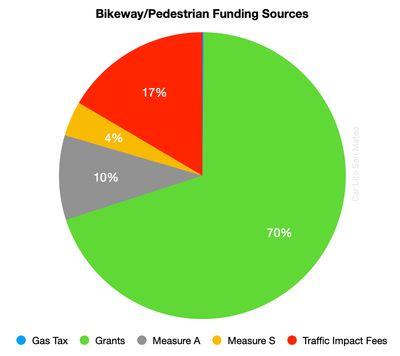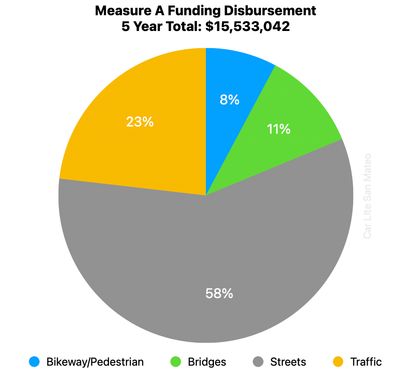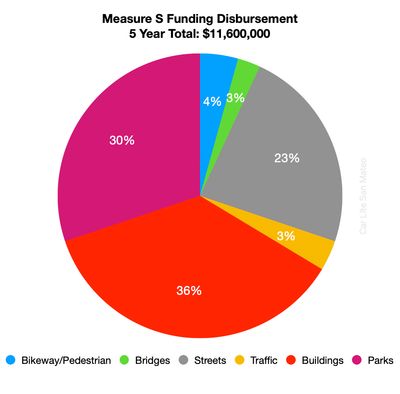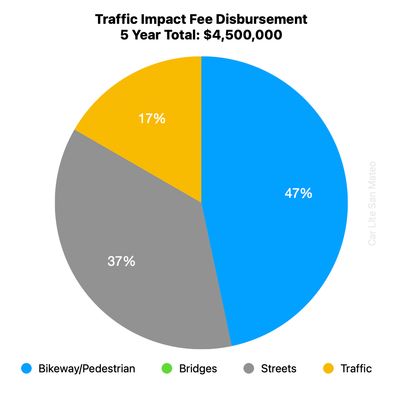City of San Mateo Bikeway/Pedestrian Budget
Funding Bikeway/Pedestrian Projects
The City of San Mateo has their Proposed 2024-26 Budget/Business Plan (big PDF warning!) posted on their website. It does a great job breaking down what the city is planning to fund and how. They include multiple types of breakdowns in this document that I think makes it much clearer than the Adopted Budgets on their main Business Plans/Budget page.
These breakdowns are important because the 2023-24 Adopted-Budget contains this claim:
The 2023 – 2028 CIP has nearly 4X the amount of funds included for Bikeway/Pedestrian CIP projects than the 2021 – 2025 CIP, reflecting the City’s investment in the projects identified in the Bicycle Master Plan 2020
This is promising as San Mateo has struggled to complete the projects in their 2020 Bike Master Plan up to this point. Using this Proposed Budget/Business Plan document we can dig into what the city's plan is for increasing funding.
Funding Breakdown
On page 202 of the proposed budget there is a table showing the sources of the ~$13 million in Bikeway/Pedestrian funding.

Bikeway/Pedestrian Funding Sources
From this table in the PDF we can breakdown the ~$13 million by funding type
| Category | Amount |
|---|---|
| Gas Tax | $20,000 |
| Grants | $8,876,000 |
| Measure A | $1,213,042 |
| Measure S | $500,000 |
| Traffic Impact Fees | $2,100,000 |
| Total | $12,709,042 |
I find it a bit easier to look at in visual form.

There is a note in the 2020 Bike Master Plan on why this funding breakdown leans so heavily on grant funding (CIP = Capital Improvement Plan).
The City includes bikeway projects in the CIP, but they are not often prioritized for funding because they can be eligible for grant funding
Categories of Funding
Before drawing conclusions on this heavy reliance on grant funding I think it is worth looking into what the different categories of funding are.
Measure A
Measure A is a county-wide half-cent sales tax first passed in 1988 and re-approved in in 2009 for transportation projects. A portion is given to cities to use for transportation and the city decides how those funds are dealt out. The chart below shows how the City of San Mateo is planning to use their Measure A funds.

The majority of this funding (~$9 million) is for re-paving city streets.
Measure S
Measure S is an additional quarter-cent sales tax for safety, public services, and infrastructure improvements. It was originally approved in 2009 with a re-approval/extension in 2015. The tax was designed as a general tax, with revenue deposited into the general fund to be used for any government purpose.

The big projects are street repaving ($3.2 million), structural improvements to the Marina Library ($2.1 million), and conversion of a field to synthetic turf ($1.5 million).
Traffic Impact Fees
The Traffic Impact Fee Fund is collected to mitigate the traffic related cumulative of new development. In practice this is a tax on new development in San Mateo. The idea is that new developments bring new traffic and the developers should have to pay for it. This source of funding is also unpredictable because San Mateo can't always know exactly when new developments make it through the finish line to pay this fee.

Takeaways
After a browse through the numbers the claim from the city of "nearly 4X the amount of funds included for Bikeway/Pedestrian CIP projects than the 2021 – 2025 CIP" is less impressive. The budgeted funds lean heavily on unpredictable and non-guaranteed funding sources. About 90% of the $13 million is budgeted to come from Grants and Traffic Impact Fees. Grants are heavily dependent on staff time and outside funding sources (and likely a bit of luck). Traffic Impact Fees require that development in San Mateo is moving forward and currently many projects seems paused because of the state of interest rates and uncertainty.
The more predictable sales-tax funding sources (Measure A and Measure S) are largely dedicated to street repaving and other city priorities. Most progress on the bike network in San Mateo comes from repaving projects where bike facilities can be added alongside regular repaving. At this point the city seems willing to add these facilities as long as vehicle parking isn't impacted which is slowly moving the needle.
Having the larger vision of the bike network depend heavily on these unpredictable sources makes it difficult to predict progress on our currently disconnected bike network. It will be interesting to follow the reality of funding and whether the city can deliver on these aggressive targets for funding.
- ← Previous
City of San Mateo Bike Master Plan - Next →
Vehicle Trip Lengths in San Mateo
